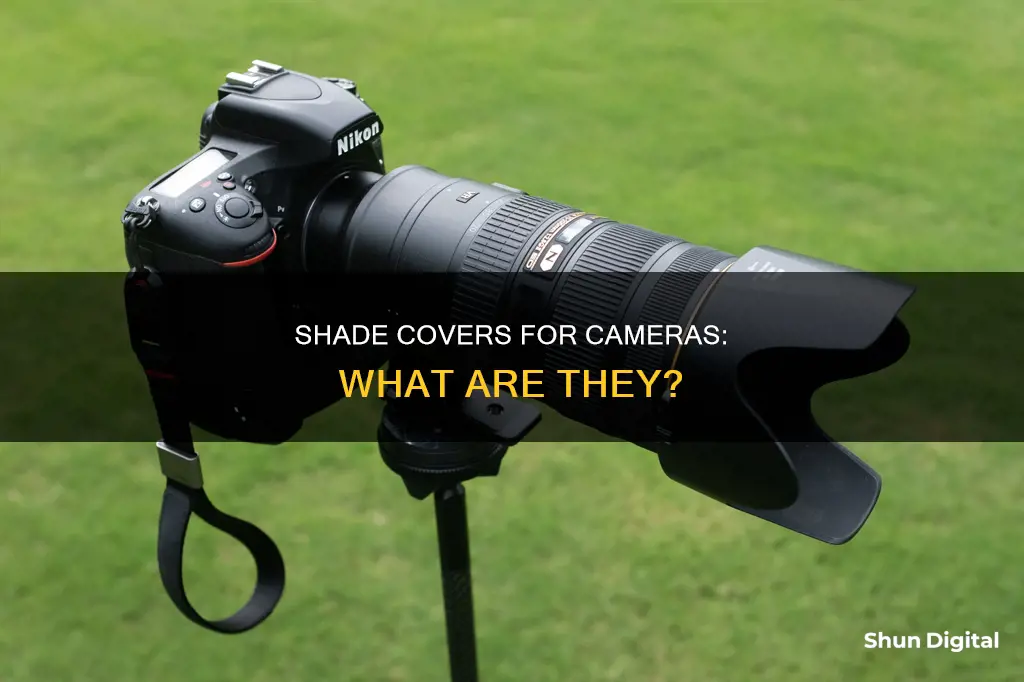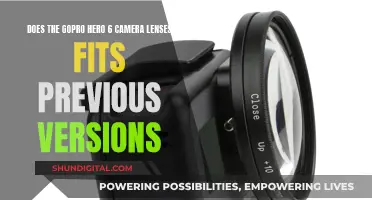
The shade cover for camera lenses is called a lens hood or lens shade. It is a device attached to the front end of a lens to block unwanted light from hitting the lens and causing lens flare and glare.
| Characteristics | Values |
|---|---|
| Name | Lens hood or lens shade |
| Purpose | To block unwanted light and prevent glare and lens flare |
| Protection | Adds a layer of protection against accidental impacts, scratches, fingerprints, rain, snow, dust and other debris |
| Geometry | Depends on the focal length of the lens, the size of the front lens element, and the dimensions of the image sensor or film in the camera |
| Types | Cylindrical, petal, tulip, or flower hoods |
| Compatibility | Designed for specific lenses, with some universal options available |
| Storage | Can be stored by attaching it to the lens in reverse or stacking multiple hoods together |
What You'll Learn

Lens hoods block unwanted light, preventing glare and lens flare
In photography, a lens hood or lens shade is a device attached to the front end of a lens to block unwanted light from the Sun or other light sources, preventing glare and lens flare.
Lens flare occurs when stray light from bright light sources, such as the Sun or studio lights, enters the lens and bounces around within it. This can wash out your image, reduce contrast and overall image quality, and create discolourations.
Lens hoods act as visors, shielding the lens from unwanted light and reducing the chances of lens flare or glare. They are particularly useful when shooting outdoors or in any situation with strong light sources, such as when shooting into the sun or near street lamps at night.
Lens hoods also offer some physical protection for the lens, reducing the risk of accidental impacts, scratches, fingerprints, and damage from harsh weather conditions. They can also protect the lens from water droplets and spray when shooting in rainy or misty conditions, or near waterfalls or the sea.
Lens hoods come in two main shapes: cylindrical and petal (or tulip). Cylindrical lens hoods are longer and used with prime or telephoto lenses, while petal lens hoods are shorter with curved notches and used with wide-angle lenses and full-frame camera sensors.
Understanding APS-C Camera and Lens Cropping: What's the Difference?
You may want to see also

They add image contrast by reducing discolouration and enhancing colours
The shade cover for camera lenses is called a lens hood. They are usually made of plastic or metal and attach to the front of a camera lens.
Lens hoods add image contrast by reducing discolouration and enhancing colours. When lens flares and strong glares of light hit a camera lens, they wash out the image and reduce contrast and overall picture quality. This is due to discolouration and a loss of image clarity. A lens hood prevents stray light from entering the lens, ensuring that it gets a clear view of the scene being photographed. This results in more vibrant and punchy colours and enhances image quality.
Lens hoods are particularly useful when:
- The subject is backlit
- You are shooting near strong light sources, such as the sun, street lamps, or car lights
- Your photoshoot is long, and you cannot put your camera down
- You are using an off-camera light source that creates a lens flare
Lens hoods are not useful when:
- You want a glare effect in the photo for artistic purposes
- The lens is intended for a smaller sensor, and the hood is showing up in your photos
- You are using certain filters or accessories on your lens that prevent you from attaching a hood
- The lens hood is catching the wind and causing blurry photos
Understanding Camera Lenses: A Beginner's Guide to Photography
You may want to see also

Lens hoods protect the lens from scratches, fingerprints, rain, and other debris
The shade cover for camera lenses is called a lens hood. Lens hoods are designed to protect the lens from scratches, fingerprints, rain, and other debris. They are usually made of plastic or metal and attach to the front of the lens. While their primary function is to reduce lens flare by blocking stray light, they also serve as a protective barrier.
Lens hoods are particularly useful when shooting outdoors or in harsh weather conditions, as they prevent rain, snow, and other elements from damaging the lens. They also add an extra layer of protection against accidental bumps, scratches, and fingerprints. This can be especially useful when shooting in crowded areas or in challenging environments.
In addition to protecting the lens, lens hoods can also improve image quality. By reducing lens flare and glare, lens hoods enhance contrast and colour saturation, resulting in more vibrant and dynamic photographs. This is achieved by blocking unwanted light from entering the lens, which can cause a washed-out or hazy effect.
Lens hoods come in various shapes, including cylindrical and petal or tulip designs. Cylindrical lens hoods are typically used with prime or telephoto lenses, while petal lens hoods have curved notches that maximise the frame size offered by wide-angle lenses. The shape of the lens hood depends on the lens's focal length, the size of the front lens element, and the dimensions of the image sensor or film in the camera.
It is recommended to use a lens hood whenever possible to protect the lens and improve image quality. However, there may be times when a photographer chooses to remove the lens hood, such as when they intentionally want to create a lens flare effect or when using certain filters or accessories that are not compatible with the hood.
The Magic of Camera Lenses: How They Attach
You may want to see also

They are easy to attach and store
Camera lens hoods are easy to attach and store. They are usually screwed onto the front of the lens and can be removed or reversed for storage. Some lens hoods can be stored by attaching them to the lens in reverse, which saves space in your camera bag. This is possible with most lens hoods, except for some wide-angle lenses where it is built-in.
If you are using a set of lenses with hoods of different sizes, you can save space by stacking them inside each other. You can also thread the camera strap through the hoods and secure them outside the bag.
Lens hoods are usually made of lightweight plastic or metal, so they are easy to carry around. They are also cheap to replace if lost or damaged.
The Ultimate Guide to Storing Your Camera and Lenses
You may want to see also

There are two main types: petal and cylindrical
The shade covers for camera lenses are called lens hoods. They are used to block unwanted light from entering the lens and causing lens flare, which can reduce the contrast and quality of the image. They also offer some protection to the lens from scratches, bumps, and the elements.
There are two main types of lens hoods: petal and cylindrical.
Petal Lens Hoods
Petal lens hoods, also known as tulip or flower hoods, have curved notches that block out light while maximising the frame size offered by wide-angle lenses and full-frame camera sensors. They are designed to block every bit of ambient light, with the notches accommodating the four corners of the rectangular camera sensor. This means that petal hoods must be positioned correctly, as rotating them incorrectly can result in the hood being captured in the photo.
Cylindrical Lens Hoods
Cylindrical lens hoods are simple in design and work well to block stray light and protect the lens. They are usually used with prime or telephoto lenses, and their long shape rarely shows up in the frame as the field of view becomes smaller with longer focal lengths.
Lens hoods are essential accessories for photographers, improving image quality and protecting lenses. They are easy to use and can be attached to the front of the lens, or reversed and stored on the lens when not in use.
Understanding Camera Lenses: Capturing Unique Perspectives
You may want to see also
Frequently asked questions
The shade covers for camera lenses are called lens hoods.
Lens hoods are used to block unwanted light from entering the lens, reducing lens flare and glare, and improving image contrast.
You should use a lens hood when shooting outdoors or in any setting with strong light sources, such as the sun or bright studio lights. They are particularly useful when your subject is backlit or when you are shooting near street lamps, building lights, or car lights.
Yes, there are two main types of lens hoods: cylindrical lens hoods and petal (or tulip) lens hoods. Cylindrical lens hoods are typically used with prime or telephoto lenses, while petal lens hoods are designed for wide-angle lenses and full-frame camera sensors.







